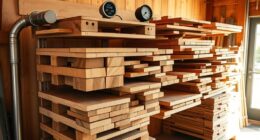When choosing a drawer box construction, consider the strengths of each method. Dovetail joints offer outstanding strength and a beautiful look but require precise craftsmanship. Box joints provide a simple, durable option with easier assembly, ideal for everyday use. Lock-rabbet joints balance strength and simplicity, perfect for quick builds or added stability. By understanding these techniques and material choices, you’ll improve your drawers’ durability and appearance—keep exploring to find out more about these construction methods.
Key Takeaways
- Dovetail joints offer superior strength and aesthetics, ideal for high-quality drawer construction.
- Box joints are simpler to produce with a jig and provide solid, durable connections for everyday use.
- Lock-rabbet joints combine rabbet cuts and grooves for quick, clean, and stable drawer assembly.
- Material choice, especially hardwoods, enhances joint durability and prevents splitting during assembly.
- Combining appropriate joint types with quality materials ensures long-lasting, professional-looking drawers.

Have you ever wondered what makes a drawer box sturdy and smooth to operate? It all comes down to the joint types and material selection you choose during construction. The joints are the backbone of the drawer’s strength, preventing wobbling and ensuring longevity. When selecting materials, you want something durable yet workable, like hardwoods such as maple or oak, which resist wear and provide a solid base for joints. The right combination of joint type and material creates a drawer that feels premium and performs reliably over time.
The most common joint types for drawer boxes are dovetail, box joint, and lock-rabbet. Each has its strengths and is suited to different levels of craftsmanship and aesthetic preference. Dovetail joints are often considered the gold standard, primarily because they lock together tightly with interlocking pins and tails. This joint is not only incredibly strong but also visually appealing, showcasing fine craftsmanship. When working with dovetails, material selection is vital; hardwoods are preferred because they hold the tight pins and tails securely, and their strength resists pulling apart under load. The process involves precise cutting, but the resulting joint resists racking and provides a lasting connection.
Dovetail joints offer strength and beauty, especially when paired with hardwoods for lasting durability.
In contrast, box joints, also known as finger joints, are simpler to make but still offer excellent strength. They feature a series of interlocking rectangular cuts that fit together snugly. Material choice here is slightly more flexible, but hardwoods continue to be ideal for durability and ease of machining. Box joints can be cut with a jig on a table saw or router, making them accessible for many builders. They provide a robust joint that handles daily wear well, especially when reinforced with glue during assembly.
The lock-rabbet joint combines a rabbet cut into the sides of the drawer box with a corresponding groove, creating a strong and straightforward connection. This joint is often used in conjunction with other methods to add stability. Material selection matters because the rabbet’s depth and fit depend on the thickness and grain of the wood. Hardwoods again are advantageous here, as they prevent splitting and maintain a tight fit over time. The lock-rabbet is quick to assemble and offers a clean look, making it a popular choice for furniture that balances strength and simplicity.
Ultimately, your choice of joint type and material determines the durability, appearance, and ease of construction of your drawer box. By understanding how these elements work together, you can craft drawers that not only look professional but also stand the test of time.
Frequently Asked Questions
Which Drawer Construction Method Is the Most Durable?
You’ll find that dovetail joints are the most durable because they excel in wood joint strength and material compatibility. Their interlocking design resists pulling apart, making them ideal for heavy use. While box-joints are strong too, dovetails offer superior longevity, especially in drawers subject to frequent opening and closing. So, if durability matters most, go with dovetail construction to guarantee your drawer holds up over time.
What Tools Are Essential for Each Construction Technique?
You need essential tools for each joint type and precise tool calibration. For dovetails, you’ll use a dovetail saw, a marking gauge, and a chisel, ensuring your tools are sharp and calibrated. For box-joints, a dado blade or a router with a jig, along with a square, are vital, with consistent calibration for accuracy. Lock-rabbet joints require a rabbet plane or a router, and maintaining proper tool calibration guarantees tight, durable joints.
How Do I Choose the Best Method for My Project?
You should choose the best method based on material compatibility and aesthetic considerations. If you want a traditional, decorative look, dovetails are ideal, especially with hardwoods. For a modern, clean appearance, box-joints work well with softer woods or plywood. Lock-rabbet joints are great for quick assembly and durability, suited for materials requiring strong, simple joints. Consider your project’s style, strength needs, and the materials you’re using to make the right choice.
Can These Methods Be Combined in One Drawer?
Yes, you can combine these methods in one drawer. Remarkably, combining techniques can enhance strength and aesthetic appeal, especially when considering material compatibility. For example, a dovetail joint paired with a lock-rabbet can provide durability while maintaining a clean look. Keep in mind, blending methods requires attention to aesthetic considerations and precise craftsmanship to ensure all parts work seamlessly together.
What Are Common Mistakes to Avoid in Drawer Construction?
You should avoid misaligning joints, which weakens the drawer’s structure, and guarantee precise joint alignment during assembly. Be careful with glue application; too much can cause messes and weaken the bond, while too little may result in weak joints. Always double-check your fit before gluing, and clamp firmly to maintain proper alignment as the glue dries. These steps help create durable, professional-looking drawers.
Conclusion
Now that you’ve explored dovetail, box‑joint, and lock‑rabbet methods, imagine sliding a perfectly crafted drawer into its housing, each joint whispering tales of precision and craftsmanship. Whether you choose the elegance of dovetails or the strength of box‑joints, your handiwork becomes a seamless part of your furniture’s story. With each cut and fit, you’re not just building a drawer—you’re creating a durable, beautiful piece that will serve for years to come.









